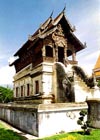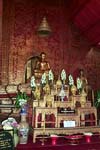Within the walls of the ancient city are several old temples of interest. Among them, Wat Pra Sing is perhaps the largest and most interesting, although it may not seem so at first glance. Upon entering the main gate, you're greeted by a large and dusty parking area. Across the lot is a large wiharn (prayer hall) with an intricately carved front. This is your first clue that there's more here than there might appear.
The altar at right is the one inside the large chapel. It's beautiful, though rather standard for Thai temples these days. We were somewhat amused by the plethora of "account books" strewn about on the right side of the altar (behind the columns in the picture we're afraid). In any temple that gets visitors, there is almost always a donation box with a guest book for you to write your name and amount donated in. Well, in this temple there were at least half a dozen boxes, each with a different purpose - maintenance of the temple building, electricity, taxes, etc. - and so each with its own account book. Upon making a donation to one or more purpose, you then have to scrabble around for the proper book to write it down in.
 Elevated ho trai with sculpted base. |
As you face the big wiharn, to your right is a small elaborate ho trai built on a high stone base. The base has many beautiful carvings which have recently been renovated, as have the gilded carvings on the gable ends. Continuing on around the complex in a counter-clockwise direction, you'll find a drum tower set in a yard shaded by many old trees. Sometimes there's an artist or two at work here, and selling their work of course.
Directly behind the large prayer hall is a smaller building that serves as the temple's ordination hall (ubosot). This is where young monks are ordained and some other important religious events are held. The wooden building shelters a large brick and plaster altar, that I suspect pre-dates the outer building and was originally out in the open. The clues to this are the altar's shape and the fact that it sits in the middle of the building rather than at one end. The orientation of the entrances on a north - south axis rather than east - west is another clue. Like the library, the ubosot has recently been restored.
 Wiharn housing the Pra Sing Buddha image. |
 The Pra Sing Buddha image. |
Next to the ubosot, in a line with the wiharn, is a large whitewashed chedi. Next to it is a small but very ornate Wiharn which is worth a closer look. The outside is decorated in gold and ochre in a style which is ornate but without the gaudiness of many other temples.
The decoration inside is also quite rich. There is a brocade-like gold and red pattern on parts of the roof and back wall behind the altar. On the altar here (and not on the altar of the main wiharn) sits the Pra Singh Buddha image from which the temple takes its name. "Pra" is Thai for a priest or cleric and also used to refer to Buddha images. "Singh" means lion, but may be a corruption of the Thai word for Sri Lanka, where the image is supposed to come from.
Wat Pra Singh was founded in the 14th century to enshrine the ashes of King Kam Fu.
From Wat Pra Singh, you might want to go on to Wat Chedi Luang, which is just a short walk away. Another important temple within the walls is the oldest: Wat Chieng Man. It's another short walk away, near the Chang Puak gate and the Thai Airways ticket office.
The entire temple was completely restored in 2005 - 2006. To see pictures of the "new and improved" temple, see our online photo gallery, part of our travel journal.
Getting There
The temple is located at the end of Pra Singh Road (what a coincidence) which nearly bisects the old city, running from the Tapae gate all the way to the temple, which is just inside of the Suan Dok gate.
No comments:
Post a Comment